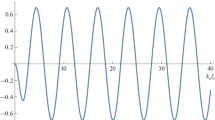Summary
The effect of three-dimensional high-frequency turbulent electric fields on the π-component of the allowed 11 S 0−31 P 1 line and the forbidden 11 S 0−31 D 2 line in atomic absorption spectra of a magnetoactive He I plasma is investigated from the coupled equations for the probability amplitudes of atomic states. It is shown that these turbulent electric fields give rise to a spectral shift of the π-component of the allowed line and to satellites about a forbidden line. The calculation reveals that the shift is proportional to the mean square stochastic electric field, and that the ratio of the intensity of the near satellite to that of the far satellite is different from the one obtained by second-order perturbation theory in the absence of a laser field. It is also shown that the spectral positions of the satellite lines are shifted in the presence of the laser field. A discussion is given of the circumstances under which these shifts and satellites should be observed. Observation of these shifts and satellites permits a quantitative determination of the intensity of the stochastic electric field and of the average electron density.
Riassunto
Si studia l'effetto dei campi elettrici turbolenti ad alta frequenza tridimensionali sulla componente π della linea permessa 11 S 0−31 P 1 e della linea proibita 11 S 0−31 D 2 negli spettri di assorbimento atomici di un plasma magnetoattivo di He I per mezzo delle equazioni accoppiate per le ampiezze di probabilità degli stati atomici. Si mostra che questi campi elettrici turbolenti danno origine ad uno spostamento spettrale della componente π della linea permessa e alla formazione di linee satellite attorno alla linea proibita. Il calcolo rivela che lo spostamento è proporzionale al campo elettrico stocastico quadratico medio, e che il rapporto dell'intensità della linea satellite vicina con quella della linea satellite lontana è diverso da quello ottenuto per mezzo della teoria delle perturbazioni di secondo ordine nell'assenza di un campo laser. Si mostra anche che le posizioni spettrali delle linee satellite sono spostate in presenza di un campo laser. Si discutono le circostanze in cui questi spostamenti e linee satelliti si dovrebbero osservare. La loro osservazione permette una determinazione quantitativa dell'intensità del campo elettrico stocastico e della densità media elettronica.
Резюме
Исследуется влияние трехмерных высокочастотных турбулентных электрических полей на π-компоненту разрешенной 11 S 0−31 P 1 линии и запрещенной 11 S 0−31 D 2 линии в атомных спектрах магнитоактивной HeI плазмы, используя связанные уравнения для амплитуд вероятностей для атомных состояний. Показывается, что эти турбулентные электрические поля вызывают спектральный сдвиг π-компоненты разрешенной линии и появление сателлитов вблизи запрещенной линии. Вычисление показывает, что указанный сдвиг пропорционален среднему квадрату стохастического электрического поля и что отношение интенсивности вблизи сателлита к интенсивности вдали от сателлита отличается от величины отношения, полученного во втором порядке теории возмущений в отсутствии лазерного поля. Также показывается, что положения линий сателлитов в спектре сдвигаются при наличии лазерного поля. Проводится обсуждение обстоятельств, при которых эти сдвиги и сателлиты наблюдаются. Наблюдение сдвигов и сателлитов позволяет количественно определить интенсивность стохастического электрического поля и среднюю плотность электронов.
Similar content being viewed by others
References
C. F. Burell andH.-J. Kunze:Phys. Rev. Lett.,29, 1445 (1972).
M. Baranger andB. Mozer:Phys. Rev.,123, 25 (1961).
J. Reinheimer:Journ. Quant. Spectr. Radiative Transfer,4, 671 (1964).
W. S. Cooper andH. Ringler:Phys. Rev.,179, 226 (1969).
W. W. Hicks, R. A. Hess andW. S. Cooper:Phys. Rev.,5, 490 (1972).
D. Prosnitz, D. W. Wildman andE. V. George:Phys. Rev.,13, 891 (1976).
S. H. Kim: unpublished (1975).
H.-J. Kunze, H. R. Griem, A. W. Desilva, G. C. Goldenbaum andI. J. Spalding:Phys. Fluids,12, 2669 (1969).
Kunze et al. (8), tried to explain this intensity ratio by extending perturbation calculation up to the fourth order. Since fourth-order perturbation calculation corrects only for terms which are small compared to the terms derived by second-order perturbation calculation, their interpretation is invalid.
L. I. Schiff:Quantum Mechanics (New York, N. Y., 1968).
W. H. Louisell:Radiation and Noise in Quantum Electronics (New York, N. Y., 1964).
E. Schrödinger:Zeits. Phys.,78, 809 (1932).
S. H. Kim andH. E. Wilhelm:Journ. Appl. Phys.,44, 802 (1972).
J. I. Powell andB. Crasemann:Quantum Mechanics (Reading, Mass., 1962).
P. W. Anderson:Phys. Rev.,76, 647 (1949).
H. R. Griem:Spectral Line Broadening by Plasmas (New York, N. Y., 1974). This book exclusively uses the line shape function of Anderson, ref. (15)P. W. Anderson:Phys. Rev.,76, 647 (1949). In view of eq. (53)–(58), Griem's considerations there on spectral-line broadening are invalid, sinceGriem treats the spectral-line shape due to the radiation field without taking into account properly the radiation field.
S. H. Kim andH. E. Wilhelm: unpublished (1976).
Author information
Authors and Affiliations
Additional information
To speed up publication, the author of this paper has agreed to not receive the proofs for correction.
Supported in part by the U.S. Office of Naval Research.
Traduzione a cura della Redazione.
Переведено редакцией.
Rights and permissions
About this article
Cite this article
Kim, S.H. Effect of high-frequency electric fields on optically excited atoms in a magnetoactive plasma. I. π-Component. Nuov Cim B 41, 345–364 (1977). https://doi.org/10.1007/BF02740889
Received:
Published:
Issue Date:
DOI: https://doi.org/10.1007/BF02740889




